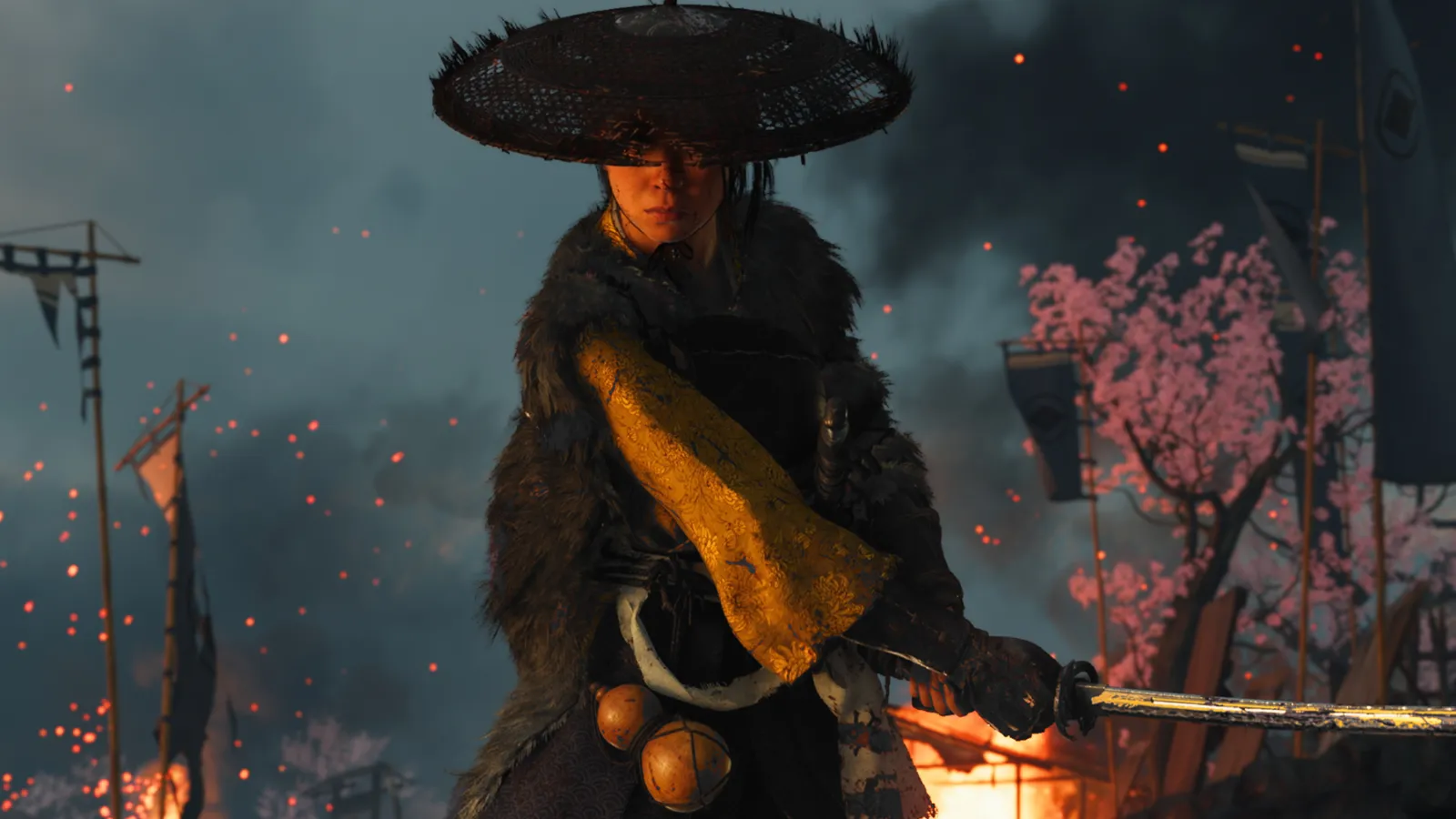
A woman stands in the doorway of a burning building, the large brim of a hat obscuring her face, her yellow hakamashita dappled red with blood. Fire dances off the hilt of the katana in her hand. Death lies in her wake. “Onryō!” the villagers hiss as she mounts a horse and disappears behind the veil of night, evoking the folk tales of vengeful ghosts who refuse to depart this mortal plane in search of revenge.
This Ghost of Yōtei haunts the red maple forests and stalks the snowy tundra in search of those whose names are written on the sash wrapped around her waist. She won’t stop until each name is crossed out in blood, and her image is soon plastered on bounty posters across the land. Shrines crop up in her honor — both from those who wish to avoid her wrath and others who approve of her killings.
Who is this Ghost of Yōtei? Is she woman or yūrei?
New ghost, new tricks
Ghost of Yōtei (out Oct. 2), Sucker Punch’s standalone sequel to 2020’s action-adventure game, Ghost of Tsushima, centers around protagonist Atsu (Erika Ishii), who lost her family at the hands of a brutal lord and dedicates her life to avenging them. Like the 1973 film Lady Snowblood (and the movie it inspired, Kill Bill), Atsu tears across the beautiful but troubled lands resting in the shadow of Mount Yōtei in search of revenge, leaving behind a bloody trail as she learns much about herself in the process.
Five years after the release of its predecessor, Yōtei expands upon Tsushima in every direction — its characters are more complex, its story more gripping, and its visuals more stunning. In Yōtei, the series’ beautiful music is tied even closer to its narrative, as is the franchise’s impressive flora and fauna.
Yōtei’s world is larger, and you explore it differently — willing settlers and unwilling rōnin with a katana at their gullet will offer hints about hot springs, wolf dens, shrines, and altars, all of which will help progress your build. You can use those hints to help pinpoint their location, an oral cartography that fills in the map bit by bit.
Editor’s picks
Atsu is a mercenary, not a samurai, so she doesn’t need to fight in accordance with their rigid values. Because of this, Yōtei’s combat is much more varied and fun than Tsushima’s. Rather than swapping katana stances to fight different enemies, Yōtei gives players several different weapons (though you’ll need to complete missions to get them).
You can beat baddies into a bloody pulp with dual katanas, a spear, a kusarigama, or an ōdachi, and swap between them on the fly (a lid for every pot, yada yada). A kusarigama’s iron weight can be swung to bash through enemy shields, a dual katana better deflects incoming spears, and a single katana always stands strongest against its mirror.
Swapping between weapons when facing a barrage of enemies can be a bit of a struggle, especially when they’re wielding a variety of weapons, but thankfully, Atsu’s dodging and parrying skills should make up for panicked swaps. As she progresses through her skill tree, Atsu can deflect away incoming arrows, unleash a flurry of dual-katana strikes, and temporarily sheath her katana just to pull it out and gut an enemy in one swift motion.
Couple that with the throwables in her arsenal (kunai that you can upgrade to light enemies ablaze, metsubushi powder to blind them, shinobi bombs that sheathe you in smoke), and Atsu is a much more formidable fighter than Tsushima’s Jin Sakai. I dreaded large battles in Tsushima, even avoided them, but welcome them in Yōtei. There are few things more satisfying than embedding a kusarigama in a man’s skull right after he hurls insults at you, then turning on a dime to throw fiery kunai at the chest of a big brute, his screams echoing through the forest.
Related Content
If you prefer to be a bit more demure in doling out death, Yōtei improves upon Tsushima’s stealth gameplay. Atsu has an entire skill tree dedicated to sneaking, and you can still take out enemies silently from afar with the thrum of a bowstring or disappear amidst the fog of a smoke bomb. It may not satisfy players who prefer stealth, but it’s more than enough for me.
Bountiful beauty
If Ghost of Tsushima was a feast for the senses, Ghost of Yōtei is a buffet (and I’m about to get kicked out after going for my fourth plate of lobster claws). There are many lovely details that Sucker Punch was clearly given the time, space, and budget to labor over.
Tsushima made use of the DualSense controller’s haptic feedback in a few, simple ways: the tension of a pulled bow string, the vibration of a cat’s purrs, the clinging of katana blades. Yōtei takes the controller and makes it feel like a real-world multi-tool.
In the opening moments, your fingers act as Atsu’s brushstrokes as she writes the names of her enemies on her sash, swiping up, down, and across the DualSense pad like you’re painting the characters. Lifting the controller and swinging it swiftly down hammers steel at Atsu’s family forge, gently pulling the trigger urges a campfire’s tendrils higher, while tilting it this way and that lowers mushrooms further into that fire for cooking.
Yōtei organically melds the DualSense’s capabilities with diegetic gameplay, all of which urge you to explore more of this world and whisper in your ear, “What’s another hour or two more?”
It’s obvious from the opening moments that Ghost of Yōtei was built from the ground up for PS5 (Tsushima originally launched for PS4 in July 2020). Atsu jumps on horseback, and the screen narrows and stretches like you’re sitting in a movie theater, the grassland of Ezo sprawling in every direction, Mount Yōtei’s snowcapped peak resting in the distance. At one point, Atsu climbs its range and skirts along the mouth of the dormant volcano, which spreads like an impossibly massive maw in every direction (Yōtei is pushing the limits of draw-distance tech).
There are visuals seared into my brain: Atsu and her horse galloping across a frozen lake that looks like blue lace agate; Atsu making camp under the green streaks of the aurora borealis; red maple leaves careening and pinwheeling in the wind in Atsu’s wake. It may be the most beautiful game I’ve ever played.
But Yōtei’s beauty isn’t superficial, nor is it an attempt to distract from its gameplay or its story. Players will want to explore Ezo to see more splendor, sure, but will also want to kill that rōnin they can barely make out that’s camping in an open field, and will definitely want to know why that one samurai at the checkpoint looks so familiar. Every element is enveloping, pulling you in until it’s time to awaken from the fugue state at 2 a.m., bleary-eyed, the screen blinking a warning about the DualSense’s battery life.
The anti-hero Ezo deserves
Whereas Tsushima slowly peels back the layers of protagonist Jin like a stubborn taro root, Yōtei tells us exactly who Atsu is from the outset: an angry young woman, doggedly chasing vengeance across an island picked apart by selfish lords and the samurai who serve them. She is single-minded and short-tempered, preferring the company of foxes, wolves, and her horse (whom I named Shimaki, the Japanese word for tornado, in my play-through) to people.
Atsu is no onryō, but she has a supernatural air about her — wolves suddenly appear to help turn the tide in a battle, launching at her enemies’ throats or latching onto their outstretched arms. If she kills enough foes without taking damage, she can invoke the Onryō Shout, which shakes the ground upon which she treads and sends her foes stumbling backward in fear.
Yet she rebukes the onryō title, and wonders why they “have to die to get revenge.” Atsu “won’t be someone’s bedtime story,” and wants desperately to define herself, yet she is taciturn, hoping that her actions will tell her tale, and frustrated when she doesn’t like how it’s told.
The more time I spend with Atsu, the more it’s clear she has the heart of a young, traumatized girl, encased in a woman’s body. That young girl was stubborn and tomboyish and skilled with a katana, yes, but she was also soft and sweet. She wanted to raise horses when she grew up, but instead spent the last sixteen years as a mercenary in war-torn lands, only to return home and realize that the very people who ruined her life are destroying everyone else’s.
Despite Atsu’s scary reputation and the horrors of its world, Yōtei is softer and more sensitive than Tsushima. There are dozens of little moments of quiet kindness and profound mourning, of gentle reflection and solemnity, of nature reaching out to Atsu, and by proxy, the player.
Birds flit around Atsu’s head and lead her to points of interest. Foxes tap their toes excitedly while she chops bamboo. When she rests at a hot spring, neck deep in cloud-blue water, a buck nestles in the grass just behind her. A wolf drops a salmon at her feet while she sleeps at her campfire.
I make it a point to save every wolf in the game, despite the side quests sucking up precious time. I believe, doggedly, this is what Atsu would want. As I lead Atsu through her story, I worry about her. I question her decisions, yet continue onward in the hopes that I can help her find peace. It’s that hope for Atsu, and for the people of Ezo, that propels me forward through a story that is so much more complicated than a typical revenge tale.
The final say
Sadly, like so many games released in the last few years, Ghost of Yōtei will launch as an unwilling soldier in an ideological culture war. When Atsu was first revealed as the game’s protagonist, reactionaries jumped to disavow the sequel, citing bad-faith reasoning that failed to hide their prejudices. Sucker Punch recently fired a developer who joked about right-wing commentator Charlie Kirk’s assassination after the same people who vowed to never play Yotei launched a cancel campaign against the studio.
It’s unclear if this will change the minds of those who already planned on boycotting the game. But after many hours with it, what is clear is that Ghost of Yōtei is a work of art. It embodies the ideology that games can lead players through a beautiful, interactive world while still giving them the agency to materially affect it. Refusing to engage with it means robbing yourself of the experience, like walking into a museum eyes closed rather than appreciating any of the paintings.
Ghost of Yōtei isn’t perfect. During my playthrough, I encountered zero progression-blocking bugs but several visual glitches, the occasional hitching enemy, and the rare, weirdly rendered NPC, but nothing broke the immersion.
Side quests are a bit same-y, which is a common problem in action games. Killing a crew of rōnin just to have one give in and hand over important information via cutscene gets tiring, yet there’s solace in climbing a shit-covered rocky outcropping to bow at a heavens-touching altar over and over again. Its world, though bigger, isn’t technically completely open, as there are barriers between regions (likely to allow for some load times, which are lightning-fast).
Trending Stories
Yet Ghost of Yōtei transports players to feudal Japan with such vivid effectiveness that it’s hard to leave it and return to the reality of the modern age. It seamlessly blends diegetic gameplay with a compelling, moving narrative that’s pushed forward by a complex cast of characters. It’s absolutely a game of the year contender, and an improvement upon Tsushima’s winning formula.
Ghost of Yōtei releases on October 2 for PlayStation 5.



